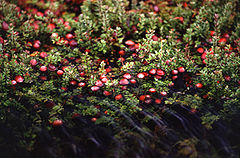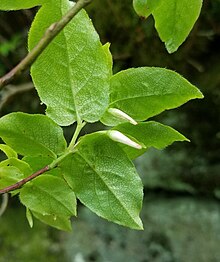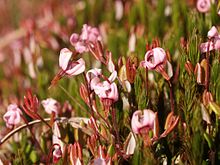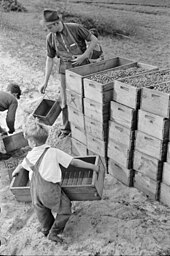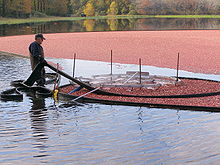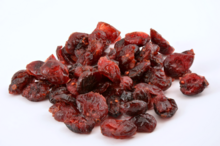
The Ericaceae are a family of flowering plants, commonly known as the heath or heather family, found most commonly in acidic and infertile growing conditions. The family is large, with c. 4250 known species spread across 124 genera, making it the 14th most species-rich family of flowering plants. The many well known and economically important members of the Ericaceae include the cranberry, blueberry, huckleberry, rhododendron, and various common heaths and heathers.

A berry is a small, pulpy, and often edible fruit. Typically, berries are juicy, rounded, brightly colored, sweet, sour or tart, and do not have a stone or pit, although many pips or seeds may be present. Common examples of berries in the culinary sense are strawberries, raspberries, blueberries, blackberries, white currants, blackcurrants, and redcurrants. In Britain, soft fruit is a horticultural term for such fruits.

Vaccinium is a common and widespread genus of shrubs or dwarf shrubs in the heath family (Ericaceae). The fruits of many species are eaten by humans and some are of commercial importance, including the cranberry, blueberry, bilberry (whortleberry), lingonberry (cowberry), and huckleberry. Like many other ericaceous plants, they are generally restricted to acidic soils.

Vaccinium vitis-idaea, the lingonberry, partridgeberry, mountain cranberry or cowberry, is a small evergreen shrub in the heath family Ericaceae, that bears edible fruit. It is native to boreal forest and Arctic tundra throughout the Northern Hemisphere, from Europe and Asia to North America. Lingonberries are picked in the wild and used to accompany various dishes, primarily in the Nordic countries. Commercial cultivation is undertaken in the U.S. Pacific Northwest and in the Netherlands.

Vaccinium macrocarpon, also called large cranberry, American cranberry and bearberry, is a North American species of cranberry in the subgenus Oxycoccus.

Ocean Spray Cranberries, Inc. is an American agricultural cooperative of growers of cranberries headquartered in Plymouth County, Massachusetts. It currently has over 700 member growers. The cooperative employs about 2,000 people, with sales of $1.2 billion in fiscal year 2013 and accounts for 70% of North American cranberry production. Their products include cranberry sauce, fruit juices, fruit snacks, and dried cranberries.

Cranberry juice is the liquid juice of the cranberry – a fruit recognized for its bright red color, tart taste, and versatility for product manufacturing. Major cranberry products include cranberry juice, dried cranberry, cranberry sauce, frozen cranberry, cranberry powder, and dietary supplements containing cranberry extracts.

Cranberry sauce or cranberry jam is a sauce or relish made out of cranberries, commonly served as a condiment or a side dish with Thanksgiving dinner in North America and Christmas dinner in the United Kingdom and Canada. There are differences in flavor depending on the geography of where the sauce is made: in Europe it is generally slightly sour-tasting, while in North America it is typically more heavily sweetened.

Vaccinium angustifolium, commonly known as the wild lowbush blueberry, is a species of blueberry native to eastern and central Canada and the northeastern United States, growing as far south as the Great Smoky Mountains and west to the Great Lakes region. Vaccinium angustifolium is the most common species of the commercially used wild blueberries and is considered the "low sweet" berry.
Proanthocyanidins are a class of polyphenols found in many plants, such as cranberry, blueberry, and grape seeds. Chemically, they are oligomeric flavonoids. Many are oligomers of catechin and epicatechin and their gallic acid esters. More complex polyphenols, having the same polymeric building block, form the group of tannins.

Sunsweet Growers Incorporated is an American agricultural marketing cooperative founded in 1917 as the California Prune and Apricot Growers Association. Sunsweet is headquartered in Yuba City, California, USA. The company operates the largest dried fruit plant in the world.
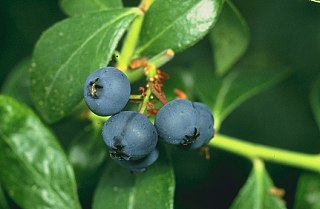
Blueberry is a widely distributed and widespread group of perennial flowering plant with blue or purple berries. They are classified in the section Cyanococcus within the genus Vaccinium. Vaccinium also includes cranberries, bilberries, huckleberries and Madeira blueberries. Commercial blueberries—both wild (lowbush) and cultivated (highbush)—are all native to North America. The highbush varieties were introduced into Europe during the 1930s.
Edward Gelsthorpe was an American marketing executive. He used his creative skills to build markets for new products such as Ban roll-on deodorant at Bristol-Myers, Cran-Apple juice for the Ocean Spray cooperative, and Manwich canned sloppy joe sauce for Hunt-Wesson.
Cran-apple juice is a blend of cranberry juice and apple juice marketed by the Ocean Spray cooperative, styled as Cran•Apple. The juice blend is marketed as combining the tartness of cranberry with the sweetness of the apple. Until 1963, when the product was first developed, cranberries were sold in the form of cranberry juice and cranberry sauce primarily around Thanksgiving and Christmas time. The Cranapple blend helped turn the cranberry into a year-round product. Cranapple started a trend and was followed by other juice blends.
Anthonomus musculus, the cranberry weevil, is a pest of blueberries and cranberries Vaccinium macrocarpon Ait. in Massachusetts, New Jersey, Wisconsin, and Michigan. A. musculus is native to North America and ranges from New England to Florida and west of the Rocky Mountains.

Monilinia oxycocci (Woronin) Honey,, common names cranberry cottonball, cranberry hard rot, tip blight, is a fungal infection of large cranberry and small cranberry. The tips of young flowering shoots wilt before they flower. Fruit that forms on the plant can then be infected by the asexual spores traveling through the plant, causing the berries to harden, turn cottony on the inside, and dry out instead of maturing. The berries are filled with a cotton-like fungus and are generally yellowish with tan stripes or blotches at maturity, making them unmarketable. It results in important economic impacts on many cranberry marshes, particularly in Wisconsin.

Vaccinium oxycoccos is a species of flowering plant in the heath family. It is known as small cranberry, marshberry, bog cranberry, swamp cranberry, or, particularly in Britain, just cranberry. It is widespread throughout the cool temperate northern hemisphere, including northern Europe, northern Asia and northern North America.
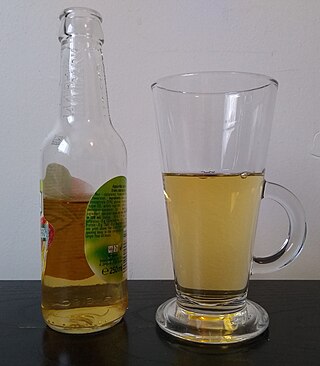
Tymbark SA, is a Polish fruit- juice beverage company. Its products are mainly available in all of 16 Polish voivodeships as well as in most of Germany. Tymbark is also a fruit and vegetable processing plant. Tymbark is a major producer of fruit and vegetable juices as well as jams, marmalades and fruit wines. In 1999, the company became part of Grupa Maspex Wadowice. The Tymbark brand was listed as Poland's 15th most popular brand in a survey by Wprost magazine. It is known as Topjoy in Hungary or Relax in Czechia and Slovakia.
Cranberry fruit rot (CFR) is a disease complex of multiple fungal agents affecting the American cranberry. Cranberry fruit rot can be categorized into field rot and storage rot. The importance of field rot and fruit rot depends on how the cranberries will be processed after harvest. If cranberries are immediately processed after harvest, growers focus on preventing field rot while with fresh market cranberries, growers seek to prevent storage rot. There are 10-15 fungal pathogens known to cause cranberry fruit rot diseases, some active in only field rot, storage rot, or both. The majority of these fungal pathogens are ascomycetes, with the rest being deuteromycetes. There is no known bacterial pathogen that plays a role in CFR or any major disease on cranberry, potentially due to the low pH conditions on the cranberry fruit.

As of 2012, there were 7,755 farms in Massachusetts encompassing a total of 523,517 acres (2,120 km2), averaging 67.5 acres apiece, but by 2017 this had declined somewhat again, to 7,241 farms in the state. Greenhouse, floriculture, and sod products – including the ornamental market – make up more than one third of the state's agricultural output. Cranberries, sweet corn and apples are also large sectors of production. Massachusetts is the second-largest cranberry-producing state in the union after Wisconsin. Agriculture in the state is served and represented by the Department of Agricultural Resources (MDAR).
